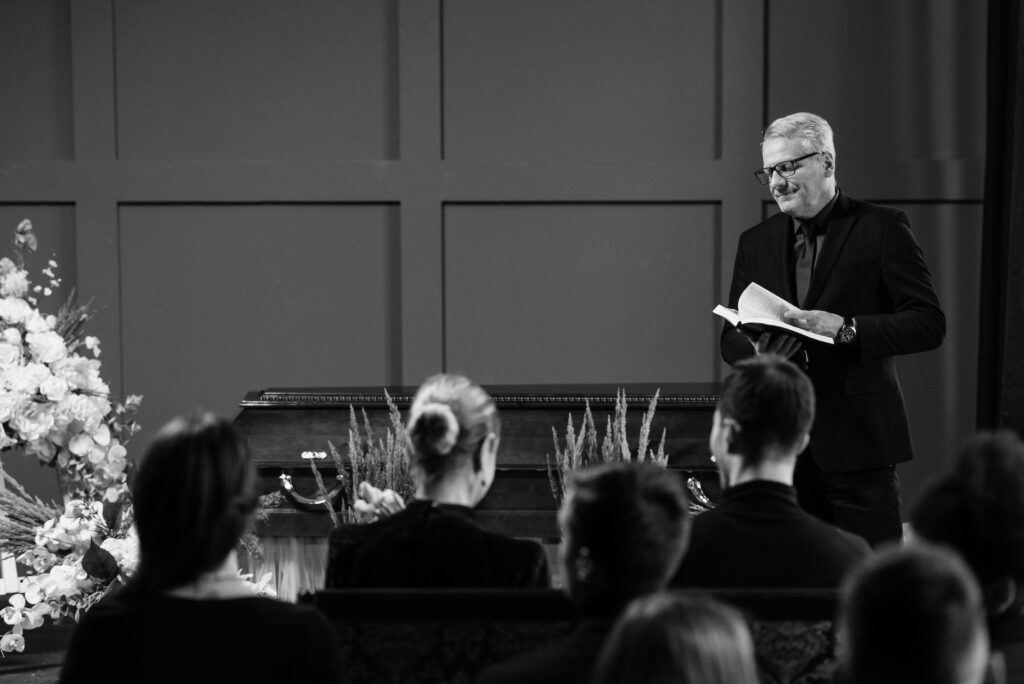How to Write a Eulogy for a Loved One?
Losing someone you cared about is never easy, even in the best circumstances. It can get a lot harder when you are asked to write a eulogy about that person’s life and how they impacted the people around them.
Writing a eulogy can be stressful, but there are ways to prepare for it and make it easier. Putting in a little effort up front and running through some drafts will allow you to get through the eulogy on the big day in front of family and friends so you can give a great send off to the person you miss.
What is a Eulogy?
A eulogy is a speech given at a funeral service. It is typically given by someone who knew the person well and can share stories of their life.
A eulogy can be serious, funny, or even lighthearted. Giving a eulogy that celebrates life depends on the person and their personality and the relationship with the deceased.
If you are writing a eulogy for your loved one, use words that will make them proud of who they were, talks about their life, and maybe includes a funny story or two.

How Long Should a Eulogy Be?
The most obvious answer to this question is that your eulogy should be as long as it needs to be. The length of a eulogy will vary depending on who you are writing it for and how close they were to you. If they were an old friend, you might only want two minutes, but if they were your child, you might stretch the eulogy to last ten minutes.
Most people who had a good relationship with the deceased will shoot for a eulogy of around 5-10 minutes. That is about 750-1,000 words of text or roughly two pages in Microsoft Word.
You can also go longer than expected if you want. However, I recommend keeping it reasonable so that no one gets bored or annoyed with listening. You can always go shorter if needed. Just remember to speak slowly, include a story that elevates the life of the deceased, and keep the remaining family in mind, so you don’t offend anyone while you say goodbye.
What Do I Include?
A eulogy is a speech about the person’s life, accomplishments, and what they meant to you. It can be funny and sad at the same time.
You’ll want to include stories from throughout their life that show how they were as a person: what was important to them? How did they contribute? What did they like doing? How did others see them?
It should be short (under 5 minutes), but it should include all of the essential details of their life. This isn’t learning how to write a novel. This is a memorial for your loved one, so try to find a story that celebrates who they were to close friends, family, and relatives that will stand out in the mind.
Find a quite place to brainstorm with the writing supplies that make you comfortable the most.

Steps to Writing a Quality Eulogy
1 - Gather Fun and Interesting Memories
Start your eulogy task by collecting stories from family members and friends. Ask them to share memories of your loved one, as well as photos and videos that show your loved one’s life. These can be put together in a scrapbook or photo album. Also, ask for their favorite songs, places, food, hobbies, quotes, and other things that made your loved one happy.
2 - Write the First Draft (750-1,000 words)
It’s time to put pen to paper (or fingers to keyboard). Write down all the memories you have of the person—the funny stories, the big moments. Then, think about what people might want to know about them or what they would want you to say if they were there. You could start by writing a list of talking points and then filling in more details when it comes time for editing.
The first draft will be messy, so don’t worry about making it perfect. But keep one thing in mind: this is not just for family members who knew the deceased well.
3 - Edit on Your Own or with AI
I suggest putting your rough draft eulogy through your own editing process first. Then using an AI-based website like:
- Grammarly – This tool is one of the best grammar checkers available, but it’s also great at checking spelling and style.
- Hemingway App – An online writing analyzer that helps identify common mistakes like weak verbs and passive voice by analyzing readability scores.
Finally, you may want to use a text-to-speech site so you can hear what your written words sound like. This will allow you to catch errors you may have missed.

4 - Practice the Eulogy with Trusted Friends and Family
Now that you have a well written draft of what you want to say, it is time to practice. Before reading your eulogy aloud in front of an audience, try it out on trusted friends and family members. If they don’t tell you they love the eulogy, at least they can offer constructive feedback so that when the day comes, everyone will be moved by your words.
I recommend having two or three people read through the eulogy with you so they can give feedback based on their own experience with the person who died. Your loved ones may also have important stories about them that could help fill gaps in your story or add some humorous anecdotes.
Don’t try too hard. You aren’t trying to be Agatha Christie, a master of prose. You are trying to write from the heart with the authenticity of your own voice.
5 - Make Edits
After you have finished writing your eulogy, it is crucial to make some edits.
- Make sure it is easy to read.
- Check for spelling, grammar, and punctuation errors.
- Make sure it’s well organized.
- Add the feedback from the beta readers you used.
6 - Practice in Front of a Mirror
Practice in front of a mirror to find a tone for your public speaking event. You want to be respectful of the family while adding humor and meaningful beats to pause during your speech.

Stay Relaxed on the Day of the Eulogy
Once the big day is finally here, it is time to deliver your eulogy to a friend or family member for any last details. Then, take a moment to relax. There are going to be a lot of emotions that you may not have felt until this point.
I remember having to give the eulogy for my father and it being a struggle the entire time because of how sad it was to lose him. I turned to humor as quickly as possible, and it lightened the mood of the audience. That helped everyone feel more relaxed and share personal stories I had never heard before about Dad.
Bonus Tip: A Simple Eulogy Structure
Part 1: Introduction of Person Who Passed
- Set the tone
- Give the details if appropriate
- Hit the highlights of their life
Part 2: Accomplishments, Stories, & Life
- Think about the person’s life, accomplishments and stories.
- Talk about what they were like, their personality, and their character.
- What kind of legacy they wanted to leave behind after their life was over.
Part 3: Summarize and Bid Farewell
- Summarize the eulogy.
- If possible, conclude your eulogy by saying something nice about the person you’re remembering.
- If you don’t know the deceased well enough to do so, ask someone who did. Even if it’s just one compliment, it can make a huge difference in how well people remember your speech and what they take away from it.
- Close with a final farewell: “Thank you,” “God bless,” or simply “Goodbye.”

Preparation Lowers Stress During a Eulogy
Eulogies are usually very personal, so it is important that you include details that matter to the person who has passed away.
You will also want to focus on their accomplishments and how they impacted your life. For example, if they were an athlete, talk about their winnings and what they meant to you as a family member or friend of the deceased. You could also go into detail about how much they liked sports or competition. This will help keep some of their personality alive through your words in the eulogy.
If someone else is involved in writing the eulogy, be patient with them as you work together. You never know if there are emotions they are trying to handle that might spill over during your collaboration.
Conclusion
Writing a eulogy is complex and requires a lot of preparation. The best way to write one is by gathering memories from friends, family members, and people who knew the deceased. It also helps if you practice your speech in front of a mirror before delivering it at the funeral or memorial service.
Take your time and try to enjoy the experience by introducing some humor and fond personal stories. This is your chance to say farewell as well, and that can be a massive weight off your shoulders when the event is finally over, and you get some closure.
